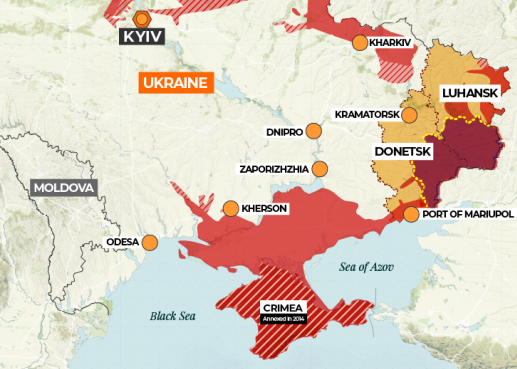What is the Peace Plan for Ukraine?
What is the Peace Plan for Ukraine?
Is there room for debate on whether the Russophone regions of the Eastern Black Sea should belong in Russia or Ukraine? They are ethnic Russians, and pro-Russian in their politics, though Ukrainians by citizenship. Their electorates vote overwhelmingly for stronger ties with Russia. Many have been granted Russian passports. That’s plenty of fuel for argument over their future. But one thing is sure: the centuries-long multiethnic equation in Ukraine is not going to be solved by America, or NATO.
It is shocking to witness Putin’s reckless aggression. It is horrifying to see the largest country in Europe attack the second-largest country in Europe. And chilling to be reminded that the larger country has a full nuclear array in its arsenal.
At some point though we must step away from the doomscrolling on our screens, to sort out the hard realities of what is ideal, and what is realistic.
Let us remind ourselves that the North Atlantic Treaty Organization is a collective security agreement: when the collective clause is triggered, all signatories become belligerents in the ensuing war.
In the visceral calls for more action, we may lose sight of the fact that bringing Ukraine under the NATO umbrella means essentially jumping into a custody battle over 28 million ethnic Ukrainians and some 14 million ethnic Russians. And all of this happening in a zone just south of Russia’s most populous regions. A zone that has been under Russia’s hegemony for centuries.
In a February 2022 YouGovAmerica poll before Russia’s invasion of Ukraine, 44% of American respondents supported Ukrainian ascension to NATO, with 36% expressly opposed.
A Pew Research poll in January 2022 found that 26% of Americans saw Russia’s military buildup on the Ukraine border as a “major threat” while 33% judged it a “minor threat.”
Do Americans understand that having Ukraine in NATO means laying claim to Russia’s geostrategic Black Sea Fleet naval base on the Crimean port of Sevastopol?
Let’s test these issues by personalizing some questions: Exactly which members of your immediate family are willing to die in the mud to keep Crimea inside Ukraine?
How much time are you personally willing to spend this year on the ground between Odessa and Mariupol getting shot at while trying to convince 14 million ethnic Russians that they should side with Ukraine instead of Mother Russia?
This writer toured Russia and Ukraine shortly after the disintegration of the Soviet Union, including the now besieged Mariupol. One could see that ethnic alliances were often stronger than political nationalities. Even then, it was unclear which government was running the show, but it was safe to walk around. That situation later deteriorated into bloodletting between the neo-Nazi Azov Brigades fighting against pro-Russian militias. They are neighbors, killing each other.
From the subjective Russian standpoint, their Motherland has been repeatedly attacked from the West, including Napoleon’s army and the Nazis. The lessons of those attacks loom large in the Russian collective memory.
They fought back the Nazis from Stalingrad all the way to Hitler’s bunker in Berlin, and then installed buffer states between Russia and the Western powers. The Ukrainian plan to bring the NATO flag right up to the Russian border was a direct challenge to that structure. Russia has now lit the fire to incinerate that application.
Beyond arms supply and a no-fly zone, both of which only postpone the inevitable, Ukraine’s choices are bleak:
- annihilation
- capitulation, and a new puppet regime that answers to the Kremlin.
- evacuation of the present government to opposition in exile.
- partition: Russia will bite off half of Ukraine, east of the Dneiper River, including Crimea.
- negotiation
The last one could yield a survival strategy on Russia’s border that has worked for other countries – a Ukraine that is neutral and nuke-free, yet has a strong defensive army. Has it ever worked before? Yes. The classic case is Finland, which shares a long border with Russia.
Even on the Black Sea, Turkey remained neutral in WWII while Nazi Germany and the Soviet Union slaughtered each other by the millions.
Putin has already expressly listed neutrality as one of his demands.
There are not many other exit doors left. Despite the press celebration of Ukrainian heroism and defiance, Ukraine is headed toward a horrific tragedy. By the end of this month Kyiv will – in all probability – be overrun by Russian tanks. Ukraine’s president Volodymyr Zelensky will be either dead, captured, or in exile.
It is time for Zelensky and NATO to realize that Ukraine does have a chance to regain its statehood – by forging a new identity as a neutral state, armed with non-nuclear defensive weapons. And forging a new future as neither NATO client nor Russian puppet.
This journal is for professionals and academic readers interested in Nation Branding, Place Branding, Ethnic Branding, and similar forms of politically-related communications and branding studies. The views expressed by the article authors are independent and do not necessarily reflect the views of Geobrands&Geopolitics editors.

